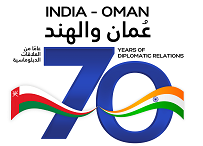Menu
Bilateral
Trade & Commerce
Labour & Community Welfare
Consular
Education
Culture & Tourism
Media Center
What's New
Ambassador's Remarks at Inauguration of 2 Artifacts at National Museum on 21 May 2022
Back | Print
Embassy of India
Muscat
***
Inauguration of 2 Artifacts from India at the National Museum of Oman
Remarks by Ambassador Amit Narang
Her Highness Sayyida Dr. Mona bint Fahad Al Said,
His Excellency Dr Abdullah Nasser bin Khalifa al-Harrasi, Minister of Information, Government of the Sultanate of Oman,
His Excellency Dr. Jamal Al Moosavi, Secretary General of the National Museum,
Distinguished guests,
Ladies and Gentlemen,
It is a distinct pleasure and honor for me to be present here at the National Museum today for the formal inauguration of the precious artifacts from India, brought on loan from the National Museum and the National Gallery of Modern Art of India.
It is particularly gratifying that these two exhibits were first announced at the National Day Reception of India on January 26 this year and have been on display at the National Museum since.
At the outset, I would like to place on record my sincere appreciation for the vision, efforts and generous support of Secretary General Dr. Jamal Al Moosavi for making this exhibition possible.
It is often said, and correctly so, that India and Oman are maritime neighbours with 5000 years of shared history.
Indeed, our two nations are ancient cultures bound by the threads of history.
The two exhibits that are being formally unveiled today are vivid examples of this shared history and cultural interchange across centuries.
The Tarikh-i-Kesari, which contains biographies of then rulers in and around India, showcases the fact that not only were the sovereigns of Oman well known in contemporary India, but that they were also well regarded.
On the other hand, the iconic painting of Fort Mirani by Thomas Daniel is a reminder of the colonial links that bound the destinies of Indians and Omanis over the past two centuries.
But most of all, what the two artifacts most vividly showcase is the shared tradition of peaceful exchange of goods, ideas and culture across the blue waters of the Arabian sea that has characterized the relationship between India and Oman.
This glorious tradition in turn contributed to the evolution of our respective cultures as modern societies well known for the value they place on the virtues of inclusiveness, openness to outside influences and universal tolerance.
Just as the Indians and Omanis take justifiable pride in their own culture and traditions, they have always kept their doors and windows open to winds of diverse influences from abroad.
This has enriched our respective cultural fabrics, fostered social harmony and helped us collectively promote peaceful co-existence on the global stage.
Today as we celebrate these two artifacts, we celebrate this shared tradition. A tradition that is a reminder that the two countries share not only thousands of years of history, but thousands of years of friendship.
I once again convey my appreciation to the National Museum and the Secretary General for their support in organizing this first-ever exhibition of historical artifacts from India.
I am confident that in the months to come, we shall have more such opportunities for collaboration, showcasing not just our shared history, but also our shared culture.
Thank you.













